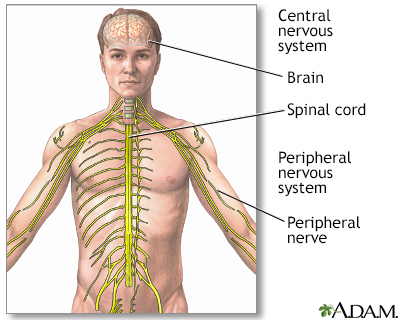Mononeuropathy
Neuropathy; Isolated mononeuritis
Mononeuropathy is damage to a single nerve, which results in loss of movement, sensation, or other function of that nerve.
Images

Causes
Mononeuropathy is due to damage to a nerve outside the brain and spinal cord (peripheral neuropathy).
Mononeuropathy is most often caused by injury. Diseases affecting the entire body (systemic disorders) can also cause isolated nerve damage.
Long-term pressure on a nerve due to swelling or injury can result in mononeuropathy. The covering of the nerve (myelin sheath) or part of the nerve cell (the axon) may be damaged. This damage slows or prevents signals from traveling through the damaged nerves.
Mononeuropathy may involve any part of the body. Some common forms of mononeuropathy include:
- Axillary nerve dysfunction (loss of movement or sensation in the shoulder)
- Common peroneal nerve dysfunction (loss of movement or sensation in the foot and leg)
- Cranial mononeuropathy III, IV, compression or diabetic type
- Cranial mononeuropathy VI (double vision)
- Cranial mononeuropathy VII (facial paralysis)
- Femoral nerve dysfunction (loss of movement or sensation in part of the leg)
- Median nerve dysfunction (carpal tunnel syndrome -- including numbness, tingling, weakness, or muscle damage in the hand and fingers)
- Radial nerve dysfunction (problems with movement in the arm and wrist and with sensation in the back of the arm or hand)
- Sciatic nerve dysfunction (problem with the muscles of the back of the knee and lower leg, and sensation to the back of the thigh, part of the lower leg, and sole of the foot)
- Ulnar nerve dysfunction (cubital tunnel syndrome -- including numbness, tingling, weakness of outer and underside of arm, palm, ring and little fingers)
Symptoms
Symptoms depend on the specific nerve affected, and may include:
Exams and Tests
Your health care provider will perform a physical exam and focus on the affected area. A detailed medical history is needed to determine the possible cause of the disorder.
Tests that may be done include:
- Electromyogram (EMG) to check the electrical activity in the muscles
- Nerve conduction tests (NCV) to check the speed of electrical activity in the nerves
- Nerve ultrasound to view the nerves
- X-ray, MRI or CT scan to get an overall view of the affected area
- Blood tests
- Nerve biopsy (in case of mononeuropathy due to vasculitis)
- CSF examination
- Skin biopsy
Treatment
The goal of treatment is to allow you to use the affected body part as much as possible.
Some medical conditions make nerves more prone to injury. For example, high blood pressure and diabetes can injure an artery, which can often affect a single nerve. So, the underlying condition should be treated.
Treatment options may include any of the following:
- Over the counter painkillers, such as anti-inflammatory medicines for mild pain
- Antidepressants, anticonvulsants, and similar medicines for chronic pain
- Injections of steroid medicines to reduce swelling and pressure on the nerve
- Surgery to relieve pressure on the nerve
- Physical therapy exercises to maintain muscle strength
- Braces, splints, or other devices to help with movement
- Transcutaneous electrical nerve stimulation (TENS) to improve nerve pain associated with diabetes
Outlook (Prognosis)
Mononeuropathy may be disabling and painful. If the cause of the nerve dysfunction can be found and successfully treated, a full recovery is possible in some cases.
Nerve pain may be uncomfortable and last for a long time.
Possible Complications
Complications may include:
- Deformity, loss of tissue mass
- Medicine side effects
- Repeated or unnoticed injury to the affected area due to lack of sensation
Prevention
Avoiding pressure or traumatic injury may prevent many forms of mononeuropathy. Treating conditions such as high blood pressure or diabetes also decreases the risk of developing the condition.
Related Information
Muscle function lossPeripheral neuropathy
Systemic
Multiple mononeuropathy
Myelin
Sciatica
Common peroneal nerve dysfunction
Radial nerve dysfunction
Ulnar nerve dysfunction
Cranial mononeuropathy VI
Cranial mononeuropathy III
Cranial mononeuropathy III - diabetic type
Axillary nerve dysfunction
Carpal tunnel syndrome
Femoral nerve dysfunction
Tarsal tunnel syndrome
References
Katirji B. Disorders of peripheral nerves. In: Jankovic J, Mazziotta JC, Pomeroy SL, Newman NJ, eds. Bradley and Daroff's Neurology in Clinical Practice. 8th ed. Philadelphia, PA: Elsevier;2022:chap 106.
National Institute of Neurological Disorders and Stroke website. Peripheral neuropathy. www.ninds.nih.gov/health-information/disorders/peripheral-neuropathy. Updated August 7, 2024. Accessed September 30, 2024.
Smith G, Shy ME. Peripheral neuropathies. In: Goldman L, Cooney KA, eds. Goldman-Cecil Medicine. 27th ed. Philadelphia, PA: Elsevier; 2024:chap 388.
BACK TO TOPReview Date: 6/13/2024
Reviewed By: Joseph V. Campellone, MD, Department of Neurology, Cooper Medical School at Rowan University, Camden, NJ. Review provided by VeriMed Healthcare Network. Also reviewed by David C. Dugdale, MD, Medical Director, Brenda Conaway, Editorial Director, and the A.D.A.M. Editorial team.

Health Content Provider
06/01/2028
|
A.D.A.M., Inc. is certified by URAC, for Health Content Provider (www.urac.org). URAC's certification program is an independent audit to verify that A.D.A.M. follows rigorous standards of quality and accountability. A.D.A.M. is among the first to achieve this important distinction for online health information and services. Learn more about A.D.A.M.'s editorial policy, editorial process and privacy policy. |
The information provided herein should not be used during any medical emergency or for the diagnosis or treatment of any medical condition. A licensed medical professional should be consulted for diagnosis and treatment of any and all medical conditions. Links to other sites are provided for information only -- they do not constitute endorsements of those other sites. © 1997- 2025 A.D.A.M., a business unit of Ebix, Inc. Any duplication or distribution of the information contained herein is strictly prohibited.
